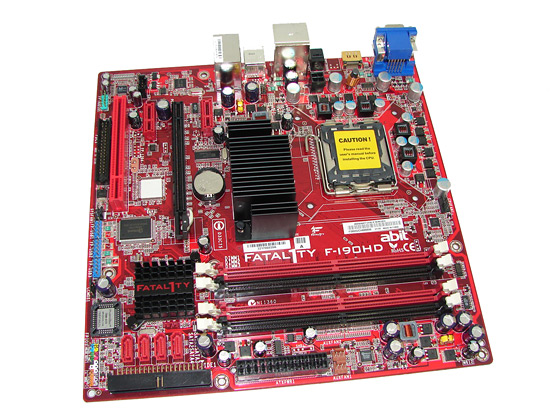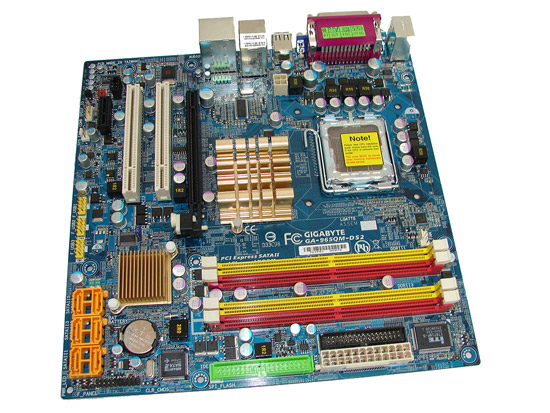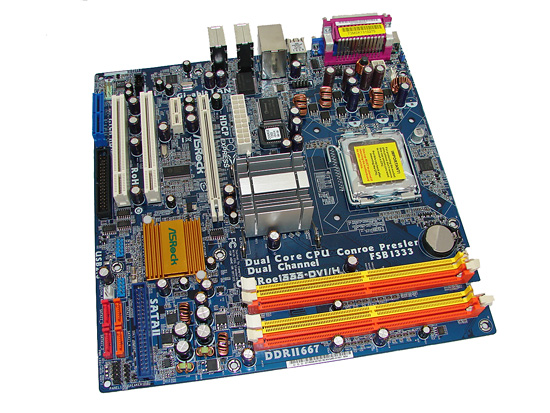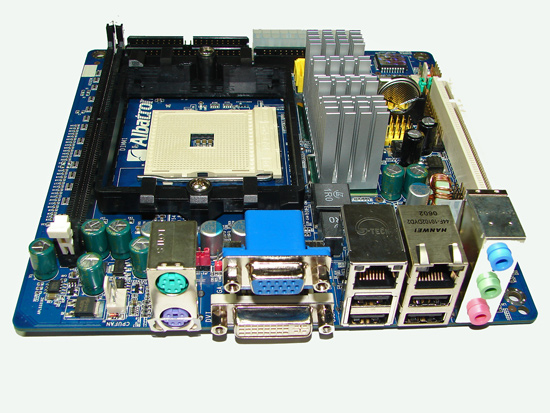Motherboard Products: Intel uATX
The Intel uATX motherboard suppliers have been slow to ramp up production of boards supporting the Core 2 Duo processor but we have several in for testing now based on the Intel G965/Q965 chipsets along with new performance enhancing graphics drivers. We are also expecting a few 946GZ based boards shortly that make a perfect match for the Intel E4xx series of Core 2 Duo processors with an 800MHz front side bus.

The abit Fatal1ty F-I90HD motherboard is based on the ATI Radeon Xpress 1250 and SB600 chipsets featuring the ATI X1250 onboard graphics capability. The board offers support for 16GB of DDR2-533/667/800 memory, four Serial ATA 3Gb/s ports, a single ATA133 IDE connector, Realtek ALC885 Audio, and Gigabit LAN. The board has VGA and HDMI outputs along with support for 10 USB 2.0 ports. This motherboard offers excellent performance for a uATX board with our E6320 CPU reaching 7x366 in the overclocking tests.

One of the more interesting Intel uATX motherboards to show up is the Gigabyte GA-965QM-DS2 that is a full featured product based on the Intel Q965 and ICH8D0 chipsets. The board features a single X16 PCI Express slot, one x1 PCI-Express slot, and two PCI 2.2 slots. There are six Serial ATA 3Gb/s ports with RAID 0, 1, 5, and 10 support, and a single ATA133 IDE connector via a J-Micron chipset. HD Audio is courtesy of the Realtek ALC888, and Gigabit Ethernet supplied by the Nineveh 82566DM chipset. We just received a performance BIOS update and will have overclocking results shortly, but the overall performance of the board has been very good to date.

ASRock has actually supplied us with a few boards for review with the ConRoe1333-DVI/H being the latest board to arrive for testing. The board is based on the venerable Intel 945G and ICH7 chipsets and features a single x16 PCI Express slot, one x1 PCI-Express slot, and two PCI 2.2 slots. There are four Serial ATA 3Gb/s ports and a single ATA133 IDE connector. HD Audio comes from the Realtek ALC888 and Gigabit Ethernet via the Realtek RTL8111B chipset. The board ships with a DVI/HDCP compliant daughter card that utilizes the single x16 PCI Express slot to provide DVI output via the 945G chipset. The board also has a standard VGA port.
AMD Mini-ITX
One of the most interesting motherboards we have seen in the labs recently is the Albatron KI51PV-754 motherboard. We found the performance of this motherboard to be very good overall. The potential market for this system spans from vehicle installations to HTPC to medical/industrial systems. If you are looking for a Mini-ITX board we highly suggest you seriously consider this offering from Albatron.

The board is based on the NVIDIA GeForce 6150 and nForce 430 chipsets. The board supports current socket 754 processors and has a single memory slot for DDR333/400 memory. Audio is provided by the Realtek ALC655 and the board features a Marvell 88E3016 10/100 Fast Ethernet PHY and a Marvel 88E8055 Gigabit LAN chipset. There are four Serial ATA 3Gb/s ports, two ATA133 ports, and a single PCI slot. The board has both a DVI and D-SUB output ports and can support HDTV output capability via an optional cable for the onboard header.
Final Remarks
Although we just briefly went over a few motherboard products, rest assured we have a significant amount of boards that will be reviewed shortly along with some exciting storage, networking, and USB flash drive roundups. We will also be introducing our Vista and Linux benchmarks for our mainstream motherboard reviews.
The Intel uATX motherboard suppliers have been slow to ramp up production of boards supporting the Core 2 Duo processor but we have several in for testing now based on the Intel G965/Q965 chipsets along with new performance enhancing graphics drivers. We are also expecting a few 946GZ based boards shortly that make a perfect match for the Intel E4xx series of Core 2 Duo processors with an 800MHz front side bus.

The abit Fatal1ty F-I90HD motherboard is based on the ATI Radeon Xpress 1250 and SB600 chipsets featuring the ATI X1250 onboard graphics capability. The board offers support for 16GB of DDR2-533/667/800 memory, four Serial ATA 3Gb/s ports, a single ATA133 IDE connector, Realtek ALC885 Audio, and Gigabit LAN. The board has VGA and HDMI outputs along with support for 10 USB 2.0 ports. This motherboard offers excellent performance for a uATX board with our E6320 CPU reaching 7x366 in the overclocking tests.

One of the more interesting Intel uATX motherboards to show up is the Gigabyte GA-965QM-DS2 that is a full featured product based on the Intel Q965 and ICH8D0 chipsets. The board features a single X16 PCI Express slot, one x1 PCI-Express slot, and two PCI 2.2 slots. There are six Serial ATA 3Gb/s ports with RAID 0, 1, 5, and 10 support, and a single ATA133 IDE connector via a J-Micron chipset. HD Audio is courtesy of the Realtek ALC888, and Gigabit Ethernet supplied by the Nineveh 82566DM chipset. We just received a performance BIOS update and will have overclocking results shortly, but the overall performance of the board has been very good to date.

ASRock has actually supplied us with a few boards for review with the ConRoe1333-DVI/H being the latest board to arrive for testing. The board is based on the venerable Intel 945G and ICH7 chipsets and features a single x16 PCI Express slot, one x1 PCI-Express slot, and two PCI 2.2 slots. There are four Serial ATA 3Gb/s ports and a single ATA133 IDE connector. HD Audio comes from the Realtek ALC888 and Gigabit Ethernet via the Realtek RTL8111B chipset. The board ships with a DVI/HDCP compliant daughter card that utilizes the single x16 PCI Express slot to provide DVI output via the 945G chipset. The board also has a standard VGA port.
AMD Mini-ITX
One of the most interesting motherboards we have seen in the labs recently is the Albatron KI51PV-754 motherboard. We found the performance of this motherboard to be very good overall. The potential market for this system spans from vehicle installations to HTPC to medical/industrial systems. If you are looking for a Mini-ITX board we highly suggest you seriously consider this offering from Albatron.

The board is based on the NVIDIA GeForce 6150 and nForce 430 chipsets. The board supports current socket 754 processors and has a single memory slot for DDR333/400 memory. Audio is provided by the Realtek ALC655 and the board features a Marvell 88E3016 10/100 Fast Ethernet PHY and a Marvel 88E8055 Gigabit LAN chipset. There are four Serial ATA 3Gb/s ports, two ATA133 ports, and a single PCI slot. The board has both a DVI and D-SUB output ports and can support HDTV output capability via an optional cable for the onboard header.
Final Remarks
Although we just briefly went over a few motherboard products, rest assured we have a significant amount of boards that will be reviewed shortly along with some exciting storage, networking, and USB flash drive roundups. We will also be introducing our Vista and Linux benchmarks for our mainstream motherboard reviews.










33 Comments
View All Comments
michal1980 - Thursday, May 3, 2007 - link
what was the point of posting this. to spit in our faces or something?'We know something you don't, nanananananana'
thats all I hear from this article.
should have just waited until you could have said something that was more usefull then a press release from a company.
plus over at hardforums, they are saying the p35 were moved up 2 weeks from may 21st to like the 7th.
xsilver - Thursday, May 3, 2007 - link
and why are you posting here?"I'm the biggest whinger here,,, nannanannana" ???
1) AT tries to pride themselves on being the best tech site out their, hence they usually need extra time to post articles or get very little sleep (anand/wes/derek/gary can probably speak for themselves)
2) In order to stay "bleeding edge" some "preview" articles may need to be written so that AT doesnt appear to be last on the bandwagon.
satisfied?
on a more pleasant note can anyone confirm whether this launch date of the 7th/21st is going to be a hardlaunch and some indications of what prices are going to be?
what about ddr3 availability?
Wesley Fink - Thursday, May 3, 2007 - link
According to Intel, the 7th is an OEM "stocking" date and the NDA lifts on the 21st. In fact Intel has not yet sampled their own versions of the Bearlake boards and the 21st NDA applies to people like Asus/Gigabyte/ECS/MSI/Abit/DFI/etc.yacoub - Thursday, May 3, 2007 - link
Dude, just use "whiner" like normal people. "whinger" looks so smarmy and a bit too much like Winger. =Pmichal1980 - Thursday, May 3, 2007 - link
bleeding edge does not = press release.or wait, is every site just a shile for the companies making the product.
At least label it as such. 'non paid ad for companies xyz'.
And they threw that line in about performance them selves.
Thats where the nannannana comes from.
"Surprising .. performance.. results... can not saying anything ethier way, or hint"
NANNANNAANA We know stuff.
Boushh - Thursday, May 3, 2007 - link
Besides the normal test you do, could you also check if coolers like the Thermalright Ultra 120 fit on the motherboards ? I think that many people that fit after market cooling solutions are interested in this information. Specially the MSI P35 Platinum has some odd looking contraptions in the CPU area...Besides that I'm still disapointed that so many manufactures have such a poor layout of the expansion slots. Specially the PCI slots. I personally need a minimum of two. And I also no the my gfx card will be a double slot one. I also want at least one slot between the gfx card and the other cards. That does not leave me with much options.
I'm disappointed that many manufactures are going for dual gfx solutions whil I recon that only a few people actualy make use of it. The dual PCIe slots eat up room. And many boards that do have a decent layout miss extra features (many current P965 boards with a decent layout miss the ICH8R). Some how people that want all the options but no dual PCIe slots messing up the layout are left in the dark.
Maybe something you could mention to the manufactures ?
Stele - Thursday, May 3, 2007 - link
Actually it's more of marketing hype - making mountains out of molehills as is unfortunately often the case with some manufacturers, who try to capitalise on the fact that your average PC buyer is not electronically-inclined.
Choke coils on motherboards, for example, have generally be wound on ferrite cores for the longest time! Same goes for 'low RDS MOSFETs'... by the way, it should be 'low RDS(ON) MOSFETs', which means MOSFETs with low Resistance, between their Drain and Source, when they are in the 'ON' state (i.e. when current is flowing through them). This allows minimum obstruction to current flow, which translates into higher efficiency and lower power dissipation (the higher the resistance, the more power is lost as heat). Again, MOSFETs with low RDS(ON) have been pretty much standard on decent motherboards for some time now... the difference is that top manufacturers use MOSFETs with very low RDS(ON), which are of course better but cost more.
As such, these claims are about as big a deal as saying that the new motherboards feature onboard 10/100Mbps NICs and onboard audio....
To be fair, Gigabyte probably meant that they're using higher-quality ferrite-core coils, and especially-low RDS(ON) MOSFETs. However, from experience, it'd most likely turn out that the components they use aren't super-outstanding as their marketing hype makes it out to be.
TA152H - Thursday, May 3, 2007 - link
Gary,There is a slight contradiction in your article. On one hand you mention how people should be interested in the motherboards you're testing based on the old chipsets, and then you mention how surprising the P35 (they are beginning to sound like fighter planes!) was for you. Hmmmm, if you were buying and you read something like that, how inclined would you be to buy the current stuff? Agreed, most people don't need the latest and greatest, but with a motherboard it's often worth it because of the technologies it supports. It's not at all clear the P35 will be expensive, at least I've heard nothing about that (maybe you know the prices better though), although it is very clear the performance is outrageous, particularly paired with DDR3. I wouldn't even consider a P965 anymore, and never would consider that rubbish NVIDIA sells at all. I think most people, particularly people reading this site, are going to feel the same way. DDR2 was a crappy technology, but from all indications DDR3 is a pretty good one, and it's becoming common knowledge the P35 is going to be the next "BX". It's worth waiting a few weeks. But then again, outside of companies like Intel and Supermicro (and even with them, to some extent) you take a risk when something new is introduced. So, that's something positive for the older stuff; you can buy stuff from second rate companies like Asus and Gigabyte and they'll probably be pretty stable by now. Buying a P35 from them would entail a lot more risk, so I guess there should still be interest in the P965, particularly since Intel and Supermicro can be quite expensive, and generally do not have the best performance.
ss284 - Thursday, May 3, 2007 - link
There have been plenty of performance reviews of the bearlake platform. Most of your post is pretty much useless.http://www.tweaktown.com/articles/1062/1/page_1_p3...">http://www.tweaktown.com/articles/1062/...earlake_...
Xtremesystems forum also has some ddr-3 testing.
The point is, performance wise bearlake will make little to no difference. Maybe 2-3% at most. ddr-3 performance suffers from high latencies and poor initial performance, much like ddr-2 when it came out. The chipset itself will be more expensive than the p965, which isn't exactly cheap right now.
TA152H - Thursday, May 3, 2007 - link
Are you crazy? So far no chipset has been able to show broad superiority over the P965, not anything from NVIDIA, or even the 975. They win at some, and lose at others. Now you see a preproduction motherboard, that is far from running optimally, and it's already outperforming it in every way! No, that's not impressive. Even with final silicon, you see improvements in performance just from changes in the BIOS, so to beat a mature design so early on is very, very impressive. When the intial boards come in, the difference will be pretty startling, unless you really have no perspective. Also keep in mind that improving performance on something with a 4MB cache is a lot harder than improving it on something with a 512K cache. Hopefully they'll test the Core 2 with the smaller cache here to show the memory controller differences a little better.I'm not going to go into all the technical merits of DDR3 because there are enough articles out there that do. It's what DDR2 should have been. DDR2 sucked did nothing but disappoint, and I'm still scratching my head as to why they released this half-baked technology instead of going straight to DDR3 like AMD wanted to. Then again, we saw RDRAM for the Pentium III, so weird things do happen.